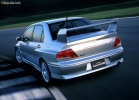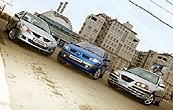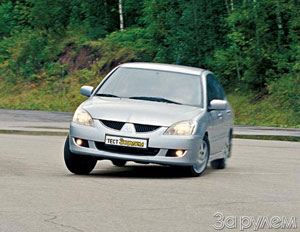Test drive Mitsubishi Lancer Evolution VII 2000 - 2003 sedan
Brother at brother
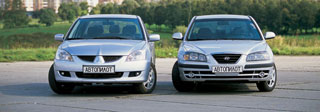 Many automobile brands connect family relationships that do not prevent them from competing. The last example is Mitsubishi Lancer and Hyundai Elantra.
Many automobile brands connect family relationships that do not prevent them from competing. The last example is Mitsubishi Lancer and Hyundai Elantra. Recently, the Korean parliament discussed the issue of changing the Latin name of the country. One of the justifications of this is approximately the following: on the Korea version instead of Corea, the Japanese insisted at the beginning of the last century to ensure that their neighbor would not be in front of the country of the rising sun at one of the first Olympiads - the teams went along the alphabet. The most developed country of Southeast Asia today already saw the beginning of a competition with a neighbor. True, this did not interfere with Japanese companies to successfully cooperate with potential rivals in the 80s. So Mitsubishi at one time sold licenses for separate models of the Hyundai concern. Now both companies are competitors in our market. If from a dozen years ago, Koreans were represented in Russia mainly in the cheapest market segments and attracted the buyer at a price, now the confrontation has gone almost on equal terms. For example, in the most popular class in Europe and Russia, these two companies offer almost identical ones in terms of characteristics and setting the model. Yes, and Elantra and Lancer are almost the same.
Silver middle. The price of Mitsubishi Lancer is almost $ 1 thousand higher than Hyundai Elantra. The reason is a richer Comfort+equipment, which includes cast discs, fog lights, side airbags and other little things. But Lancer just Comfort costs only $ 100 more expensive than Elantra GLS. That is, even a little cheaper than a round amount of $ 15 thousand, which we have the average price of a car for the middle class.
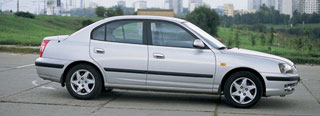 The averaging of the price, class and configuration of these models is also emphasized that both cars of the same color are always fashionable silver. It is believed that everyone likes him, and since most often the first car owner is going to sell it after a couple of years, he chooses the color not the one that he likes, but the one that most future buyers should like. But the similarity of colors allows us to more accurately evaluate the shape and style of competitors.
The averaging of the price, class and configuration of these models is also emphasized that both cars of the same color are always fashionable silver. It is believed that everyone likes him, and since most often the first car owner is going to sell it after a couple of years, he chooses the color not the one that he likes, but the one that most future buyers should like. But the similarity of colors allows us to more accurately evaluate the shape and style of competitors. And here it turns out that beauty can be understood differently. When looking at Anfas, Lancer definitely wins: a new corporate element on the hood looks very elegant. The new Elantra cladding is also good and quite peculiar, but impressive less. Effective, but new Korean headlights look somewhat rustic. However, when comparing cars in general, Elantra is more balanced and logical and visually looks, as they say, half a class higher. The appearance of the Lancer seems less integral - due to the complex geometry of the body, the trunk and the front part seem disproportionately small. Maybe this is a matter of habit? In any case, these nuances are unlikely to frighten the buyer in this segment - the price and equipment are more important here.
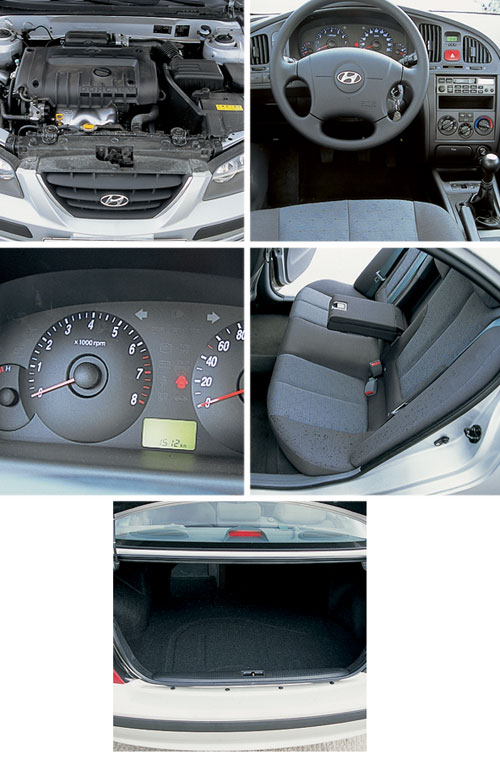
Without deception. The mentioned disproportionality of Lancer is fully justified as soon as you sit in the salon: it is very spacious. I must say thanks a rather long wheelbase - 2.6 meters. It is even more than that formally standing a step above Mitsubishi Carisma. So, even if the driver is higher than average height, only very picky or high passengers of the rear seat will complain about tightness. Although Elantra in this regard is not inferior to its neighbor and in the comfort of the rear seat can also argue with other models of the class above.
Cars are completely different in the nature of the design of the instrument panel. Hyundai prefers a restrained Europeanized style. Despite the modernization, the panel remained quite traditional. Even the spectacular semicircular scales refused more boring; But the press release mentioned the manufacturer of the instrument combination-Siemens VDO. The company is undoubtedly solid, but the most memorable detail of the new dials remains lilac backlight, which was in the previous version. True, in the center of the panel there was a monitor of an on -board computer. The set of its functions is not particularly large, but even an approximate calculation of the run until the next refueling or the average fuel consumption is enough. Very often, these data are the most useful for planning travel routes.
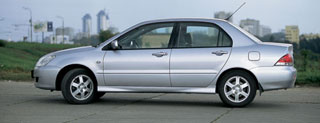 Lancer acted more boldly: a gentle panel with a shortened console creates a feeling of space and looks more likely in Japanese. As an element of luxury - a strip under a black tree. The impression spoils the sophisticated, but a clumsy audio system, which was installed additionally, and it does not fit into the design of the machine. Well, at least, the radio is located in such a way that this difference is quite tolerated. But the standard package includes only audio training, and there is always the opportunity to choose something more stylish. And the Russian buyer will like the opportunity to put what you want, and not use what they give.
Lancer acted more boldly: a gentle panel with a shortened console creates a feeling of space and looks more likely in Japanese. As an element of luxury - a strip under a black tree. The impression spoils the sophisticated, but a clumsy audio system, which was installed additionally, and it does not fit into the design of the machine. Well, at least, the radio is located in such a way that this difference is quite tolerated. But the standard package includes only audio training, and there is always the opportunity to choose something more stylish. And the Russian buyer will like the opportunity to put what you want, and not use what they give. By ergonomics and the configuration of the car are almost equal: there and there and there are no complaints. So when choosing, you can only rely on personal taste.
The only thing the Japanese loses the products of the young Asian tiger is the convenience of the trunk. Both cars have the opportunity to fold the back of the rear seat, but the opening of Mitsubishi is noticeably smaller, and in this case a couple of centimeters can turn out to be decisive.
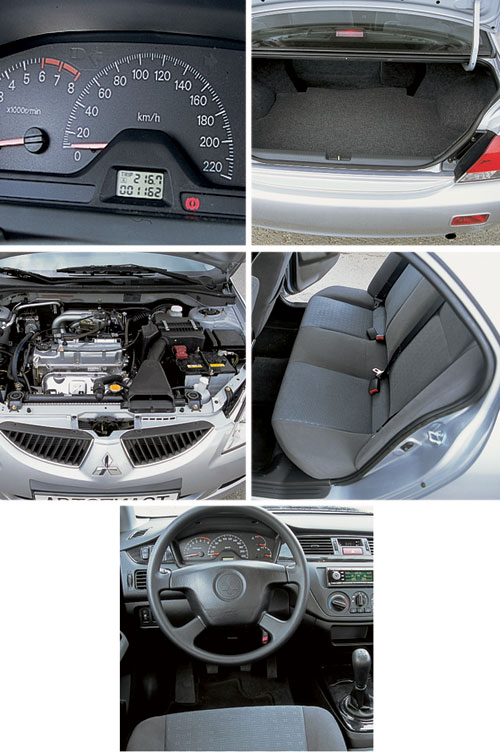
Not twins ... and so similar, and that way is almost the same. Maybe the once -related relationships of two brands have gone so far that it is necessary to choose from these machines by random poke? Nothing like this. The similarity ends when you get behind the wheel. The differences are not particularly radical, but tangible. Lancer passengers quickly notice a tougher suspension setting. This is not at all tragic and even good - it is precisely the sportsity of the chassis that ensures the clarity of reactions and the pleasure of control. Elantra more easily swallows small irregularities, and tells about large ones a muffled knock of the suspension elements, but not with sharp shocks.
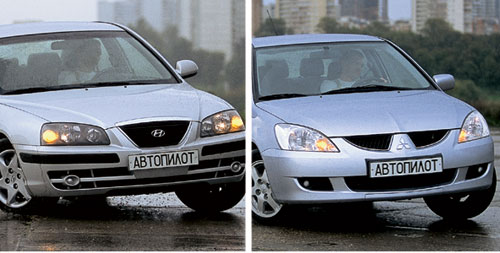
The steering on Elantra seemed less informative to us - sometimes there is not enough feedback, response reactions in complex areas are a little late. Either on the Hyundai Motor have not yet learned how to tune their units so subtly, or they do not consider it necessary: \u200b\u200bthe benefit of the main thing for the company of the North American market is going out perfectly, and the average driver in the States still prefers comfort to all kinds of sports surveys. Mitsubishi has things to do in the States too, however, sitting at the wheel of Lancer, you get much more positive emotions due to the high sensitivity and clarity of reactions.
In the process of modernization, Elantra, among other things, was revised and clutch. Alas, the former Elantra came across exclusively with an automatic transmission, so we can’t assess the difference. There are no complaints, in any case. But it would be better if a similar operation was done with a brake pedal: it is still necessary to get used to it, because the effort on the brakes changes disproportionately to a rather long move. And it turns out that on the first few millimeters, the brakes do not seem to work, and on the latter - they grasp almost until the ABS is triggered. On the other hand, there is nothing wrong with such high efficiency - just that unexpectedly fell instead of the ordered penny Altyn is also not always pleasant. At least from the point of view of the integrity of the rear bumper.
 ... but the brothers. The similarity of the characteristics of the engines also provides similar dynamics. Although here the Japanese demonstrates either the great experience of its creators, or orientation towards a different style of driving. The motors of both machines show liveliness in the range from about 3-4 thousand revolutions to 6 thousand, and both are distinguished by a noticeable increase in the sound of the engine in this case. However, in Lancer this noise annoys less than on Elantra, where a change in Temra in the region of 5000 rpm makes you think that the arrow is already close to the red zone. Maybe just on the bottoms of her motor is quieter than Lsncer?
... but the brothers. The similarity of the characteristics of the engines also provides similar dynamics. Although here the Japanese demonstrates either the great experience of its creators, or orientation towards a different style of driving. The motors of both machines show liveliness in the range from about 3-4 thousand revolutions to 6 thousand, and both are distinguished by a noticeable increase in the sound of the engine in this case. However, in Lancer this noise annoys less than on Elantra, where a change in Temra in the region of 5000 rpm makes you think that the arrow is already close to the red zone. Maybe just on the bottoms of her motor is quieter than Lsncer? In general, the Koreans have not yet been circumvented in everything, but reached the level where the issues of championship can also resolve the change in the letter in the name. However, is it worth it in this case so seriously about such trifles?
Text Valery Chusov, photo Alexey Ilyin
Model/Modification Mitsubishi Lancer 1600 Comfort+ Hyundai Elantra 1.6 GLS
Manufacturer/country Mitsubishi Motors Corporation/Japan Hyundai Motor Company/Republic of Korea
Number of doors/places 4/5 4/5
ENGINE
Type/number/location of gasoline cylinders/4/in -line gasoline/4/in -line
Working volume (cubic meter) 1584 1599
Power (kW (L.S.) at about./Min.) 72 (98) at 5000 78.5 (107) at 5800
Moment (nm at about./Min.) 150 at 4000 143 at 4500
TRANSMISSION
Front front drive
Gearbox mechanical 5-speed mechanical 5-speed
Brakes, safety
Front/rear ventilated disk/disk ventilated disk/disk
Assistering electronic systems ABS, EBD ABS, EBD
Frontal, lateral, curtains (6) frontal pillows
Dimensions/mass
Length/width/height (mm) 4480/1695/1445 4525/1725/1425
Wheel base/clearance (mm) 2600/165 2610/168
Tires 195/60 R15 185/60 R15
Massage of equipped/complete (kg) 1185/1750 1178/1780
Fuel tank volume (l) 50 55
Maximum speed (km/h) 183 182
Acceleration to 100 km/h (sec.) 11.8 11
Fuel consumption (city/highway, l/100 km) 8.8/5.5 9.1/5.7
Price in Moscow $ 15,790 $ 14,890
A source: "Autopilot"



